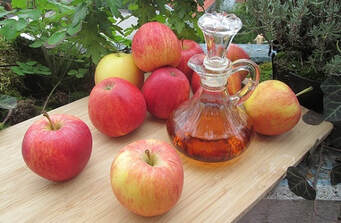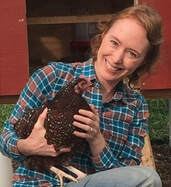
It is also useful as a natural health support for chickens (ours get a tablespoon in their water once or twice a week during cooler weather) - they love it, and it is supposed to help keep them healthy and improve their digestion.
While it's not all that expensive, if you use a lot of it, it can definitely be more cost-effective (and fun!) to make your own apple cider vinegar at home. Plus, you'll be amazed at how easy it is - and it's a great way to put those peelings and other apple scraps to good use! (Now that I know apple trimmings tend to give our chickens the runs, I'll be using them in this recipe instead after making our annual batch of apple cider this fall...) See below for a super simple and easy recipe that anyone can make at home - no special equipment required.
This recipe* takes about 4-8 weeks to complete, although you can speed it up a bit by adding a little bit of raw apple cider vinegar in the beginning.
Your vinegar should ferment at temperatures between 65-80 degrees, but keep in mind at the cooler end of this spectrum the fermentation will happen more slowly.
What You'll Need:
- Apple peels and cores
- Large glass bowl
- Water (chlorine-free)
- Sugar (Optional)
- Raw apple cider vinegar (with the mother) (Optional)
- Ceramic or glass pie plate
- Kitchen towel
- Canning jars & rings
- Cheesecloth (or squares of other clean cloth)
Instructions:
- Wash, peel, and core your apples - or gather your peelings you've saved in the freezer.
- Place all your apple scraps in a large glass, ceramic, or stoneware bowl, and cover with water by about 1". (As with any ferment, you will want to make sure your water is free of chlorine, which will inhibit the fermentation process. If your tap water is chlorinated, you can filter it using a reverse osmosis filter, or boil it (uncovered) for several minutes, and then let cool (uncovered), which should remove the chlorine.)
- Optional: If you would like to speed up the fermentation process, add 1/4 cup sugar and/or 2 TB raw apple cider vinegar (shake it up first so you make sure you get some of the mother) for each quart of water that you used.
- Cover the bowl with a heavy plate or glass or ceramic pie plate that fits just inside the bowl, making sure the apple scraps are completely submerged. (Make sure there is a bit of space inside the bowl but above the plate for the liquid to foam up, as it will start to bubble as it ferments.)
- Cover with a clean kitchen towel and set in a dark location at 65-80 degrees for 1 week.
- After a week, strain out the apple solids and pour the liquid into sterilized canning jars, leaving about 1" of head space. (Compost the solids or feed them to your animals.)
- Cover each jar with a square of doubled cheesecloth or other thin, clean cloth, and screw the ring onto the jars. This will allow your ferment to breathe while keeping insects out.
- Place jars on a dark, cool pantry shelf, and wait.
- You can check them periodically and you should start to see a film forming on the top of the liquid after a few weeks. This is the "mother," so you don't want to skim this off! You can swirl the jars to help it settle, and more will continue to form. (If you do see any black mold forming on top, be sure to skim off and discard that.)
- After about 6 weeks (perhaps less if the temperature is warm and you used sugar and/or an ACV starter; or slightly longer if temperature is cool and you didn't use either of the boosters mentioned), your vinegar should have taken on a darker color with some sediment in the bottom, and should smell very vinegary. At this point, you can cap and store your vinegar.
- Remove the cheesecloth, put lids and rings on your jars, and store in a cool, dark place. This should now be a shelf-stable vinegar that will last indefinitely and can be used as you would any apple cider vinegar.
That's all there is to it! Now that you know how easy it is to make your own apple cider vinegar, you'll wonder why you ever bought it from the store! :-)
Rose.
* Recipe Adapted from FreshEggsDaily.com.



 RSS Feed
RSS Feed